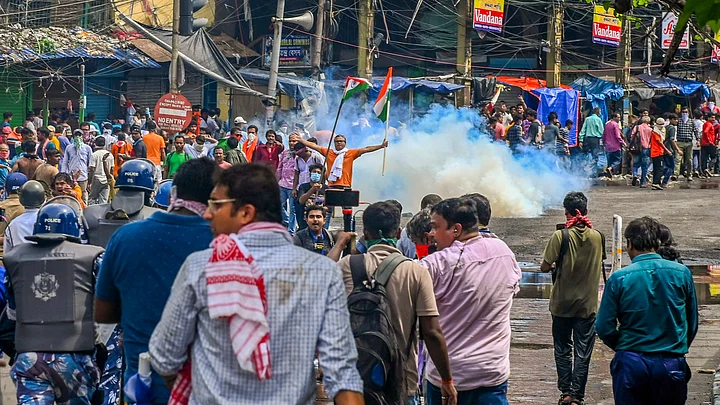Tuesday, 27 August saw a downpour of outrage against the Mamata Banerjee government when bands of youths marched from different corners of the twin cities of Kolkata and Howrah and tried to reach Nabanna, the seat of power in West Bengal, to demand the chief minister's resignation.
Protesters asserted that Mamata Banerjee holds the health portfolio and the home portfolios, and therefore, should resign accepting the responsibility for the heinous rape and murder of a medical student at Kolkata's RG Kar Hospital on 9 August.
It’s a failure of the worst kind, they charged.
Even as bouts between protesters and the security personnel continued in Kolkata and Howrah, that too for hours, Sukanta Majumdar, state president of the Bharatiya Janata Party (BJP), announced a 12-hour dawn-to-dusk bandh in West Bengal on Wednesday, 28 August, to protest the alleged police atrocities on peaceful demonstrators.
During the day, unable to control the mobs, the police lobbed smoke bombs, fired tear gas shells, sprayed water cannons and even lathi-charged protesters in at least a dozen places. The protesters, in the face of police action, retreated temporarily but regrouped and reappeared on the roads, unrelenting in their march to Nabanna.
Though they broke through the iron cordons at several places, the protesters could not reach the vicinity of Nabanna which remained an impregnable fortress. But the unfolding spectacle of bleeding policemen and protesters uprooted guard rails, and broken barriers on streets of Kolkata certainly made for bad optics for a government already reeling under public outrage.
Political Angle?
The Central Bureau of Investigation (CBI) has taken over the case and the Supreme Court has also issued guidelines but some questions regarding the ghastly crime remain unsolved even three weeks on.
There was a tense build-up to Tuesday’s confrontations which paralysed normal life to a great extent as arterial roads were closed down to early morning traffic.
The police had declared the march “illegal” when an unknown body known as the Paschim Banga Chhatra Samaj (Society of Students in West Bengal) announced it a couple of days back. Background checks of the leaders of this march by the police revealed they were closely linked to the BJP and its affiliated bodies. At a press meeting, the leaders did not deny their association with the BJP but said that they wanted to march without raising any political banner.
The student leaders invited at least one person from each home, cutting across political affiliations, to join the march. It was a bid by the organisers to rope in civil society's support similar to the 14 August 'Reclaim the Night' protests. The student body also urged people to carry the national flag.
But Tuesday’s call did not seem to evoke the same response as 14 August as people realised that there was, indeed, a “political agenda” albeit without the flag. The BJP state unit almost immediately lent its support to the march, while the Left parties officially declared that they would not join it. The agitating doctors announced that they too would not join the protest even though they continued to boycott the OPDs in state-run hospitals.
Public transport in Kolkata was scant during the day. Since early morning, Kolkata and Howrah appeared battle-ready with security personnel teeming in different outfits – the Rapid Action Force, combat units, water cannon forces, and women commandos taking their positions.
Unprecedented Fortification
To add to the gravity of the situation, huge containers were brought in with the help of JCBs and placed across roads to block free passage, a scene witnessed for the first time in Kolkata. Guard rails as high as 10 feet were erected at vantage points and workers were seen wielding those rails with gas cylinders to ensure the protesters did not breach the cordons.
Officers were seen and heard blaring on microphones that the police would not interfere with peaceful protesters, but no one should try to break the law. Nabanna is a protected zone and should not be approached, they said.
Significantly, the police officers deployed on the streets were seen without any firearms during the rally. This was at Mamata's behest who wanted to ensure that there was no firing, whatever the provocations.
Four alleged BJP supporters were arrested by the police a day before the march for spreading "fake" videos. Manoj Verma, a top police official, said they had specific intelligence inputs from social media that there were plans to create disturbances during the day’s march.
The protests, in a way, marked a departure from what Kolkata in particular, and the state in general, had been witnessing in the wake of the rape and murder. It had generated unprecedented outrage from the civil society – something that Bengal had not witnessed in decades. School students, veterans, writers, authors, actors, and ordinary citizens all united in protest against the crime.
Tuesday’s protests, however, lent a political twist to the issue, in sharp contrast to citizens' spontaneous outrage seen so far. Politics will certainly have its way, but one will earnestly pray that it does not dilute and vitiate the strength and vigour of the state's collective conscience.
(The writer is a Kolkata-based senior journalist. This is an opinion piece, and the views expressed above are the author’s own. The Quint neither endorses nor is responsible for the same.)
(At The Quint, we question everything. Play an active role in shaping our journalism by becoming a member today.)
